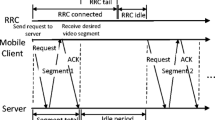Abstract
Power saving is a salient issue regarding the 4G LTE network. In wireless networks, the frequent checking of the usage of the user equipment may lead to excessive power consumption, and the discontinuous reception mechanism of the LTE is implemented to avoid such excess. The DRX trade-off metrics between power saving and the delay constraint are investigated here for an improvement in the performance. In order to meet the UE QoS, this paper suggests a predictive mechanism with a delay constraint for the traffic patterns. The results for various traffic patterns show that the suggested mechanism offers beneficial power-saving effects while satisfying the UE QoS.







Similar content being viewed by others
References
Ansari A, Jaumard B, Cavdar C (2017) Energy optimization of a cellular network with minimum bit-rate guarantee. In: 15th International Symposium on Modeling and Optimization in Mobile Ad Hoc and Wireless Networks (WiOpt), pp 1–6
ETSI Technical Report (1998) Universal mobile telecommunications system (UMTS); selection procedures for the choice of radio transmission technologies of the UMTS, UMTS 30.03, v3.2.0
Ferng H, Wang T (2018) Exploring flexibility of DRX in LTE/LTE-A: design of dynamic and adjustable DRX. IEEE Trans Mob Comput 17(1):99–112
GPP TS 36.321 (2015) Medium Access Control (MAC) protocol specification, v12.7.0
Lauridsen M, Berardinelli G, Tavares FM, Frederiksen F, Mogensen P (2016) Sleep modes for enhanced battery life of 5G mobile terminals. In: Proceedings of IEEE 83rd Vehicular Technology Conference (VTC), pp 1–6
Liu E, Ren W (2015) Performance analysis of a generalized and autonomous DRX scheme. IEEE Trans Veh Technol 64(5):2148–2153
Liu E, Zhang J, Ren W (2011) A counter-driven adaptive sleep mode scheme for 802.16e networks. In: Proceedings of IEEE 73rd Vehicular Technology Conference (VTC), pp 1–5
Liu E, Zhang J, Ren W (2011) Adaptive DRX scheme for beyond 3G mobile handsets. In: Proceedings of IEEE Globecom, pp 1–5
Lu SF, Wang JX, Kuang YJ (2010) An efficient power saving mechanism for sleep mode in IEEE 802.16e networks. In: Proceedings of International Wireless Communications and Mobile Computing Conference, pp 916–920
Mihov YY, Kassev KM, Tsankov BP (2010) Analysis and performance evaluation of the DRX mechanism for power saving in LTE. In: Proceedings of 26th Convention of Electrical and Electronics Engineers (IEEE), pp 520–524
Ramazanali H, Vinel A, Yavuz E, Jonsson M (2017) Modeling of LTE DRX in RRC Idle state. In: Proceedings of IEEE 22nd International Workshop on Computer Aided Modeling and Design of Communication Links and Networks, pp 1–5
Acknowledgements
This research was supported by Research Base Construction Fund Support Program funded by Chonbuk National University in 2018. This research was supported by Basic Science Research Program through the National Research Foundation of Korea (NRF) funded by the Ministry of Education (2016R1D1A1B01014615).
Author information
Authors and Affiliations
Corresponding author
Additional information
Publisher's Note
Springer Nature remains neutral with regard to jurisdictional claims in published maps and institutional affiliations.
Rights and permissions
About this article
Cite this article
Jung, J., Marakhimov, A. & Baek, J.H. Improvement and performance analysis of a power-saving mechanism considering traffic patterns. J Supercomput 76, 8214–8224 (2020). https://doi.org/10.1007/s11227-019-02798-6
Published:
Issue Date:
DOI: https://doi.org/10.1007/s11227-019-02798-6




